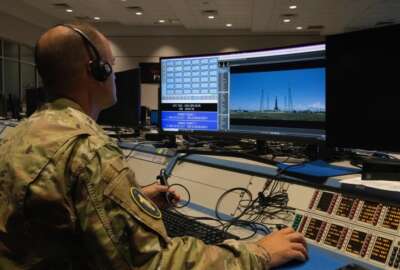As the Space Force expands and defines the roles of its different commands, one of its top priorities will be intelligence gathering in space. In a service so new no one has had time to wear the shine off their buttons, Space Operations Command (SpOC) will take a major role in the business of spying, satellites and satellite imagery.
SpOC is the Space Force’s component of U.S. Space Command, and will carry out the majority of Defense Department’s space Intelligence, Surveillance and Reconnaissance (ISR) gathering, according to SpOC Commander Lt. Gen. Stephen Whiting.
Whiting said his command provides 90-95% of Space Command’s operational capability.
“We prepare combat ready, ISR lead, cyber secure space and combat support forces. Combat readiness is the coin of the realm and SpOC, because we are that operational fighting force, we have lead intel, lead ISR, lead in everything we do,” said Whiting in a recent online interview with the Center for Strategic and International Studies.
U.S. Space Command is a joint combatant command with five components. In addition to SpOC, it includes Space and Missile Defense Command from the Army, Marine Corps Forces Space Command, the 1st Air Force and Joint Force Headquarters-Cyber as the cyber defense component.
Within SpOC, the recently formed Delta 7 command carries responsibility for tactical ISR. Whiting said Delta 7 will see expansion over the next couple of years, and as they add squadrons, they will be able to expand intelligence gathering. He said as they consolidated space ISR intelligence operations, they pulled in groups that were spread throughout the Air force and brought them together under the Space Command umbrella.
The move to increase Space Force’s role in intelligence gathering was highlighted by a recent directive from the Department of Defense on space policy, which included a directive to “enhance DoD and Intelligence Community (IC) partnership to increase unity of effort and the effectiveness of space operations and space-related activities.”
“It has done some exciting things such as embedding an intel detachment into each of our other deltas that’s executing those missions,” Whiting said. “It’s bringing the tactical level intel that our space operators need right into their office center. And we’re executing a model we like to call right seat-left seat, where that space operator is sitting right beside that intel professional, executing their mission, getting the intel they need. And so we really help close that gap.”
In addition to the tactical ISR intelligence gathering that comes from Delta 7, SpOC has a separate command that works with the national intelligence community at a strategic level.
The National Space Intelligence Center, led by Delta 18, officially launched in June of this year and is based at Wright Patterson Air Force Base in Ohio. The command is co-located with the National Air and Space Intelligence Center (NASIC), the Air Force’s ISR intelligence center. Both commands work in coordination with other space intelligence gathering organizations including the National Reconnaissance Office, the National Security Agency and the National Geospatial-Intelligence Agency, said Whiting.
“That’s our service foundational intel center, every service has one of those. It’s doing that foundational intelligence, which informs policy makers, decision makers, it informs acquisition,” he said. “And of course, we’re doing that in partnership with the Air Force’s intel center, the National Air and Space Intel center, NAVCENT, but very excited about how we have improved each of those layers of intelligence to make sure that it is informing all parts of the Space Force and U.S. Space Command.”
Copyright
© 2024 Federal News Network. All rights reserved. This website is not intended for users located within the European Economic Area.

